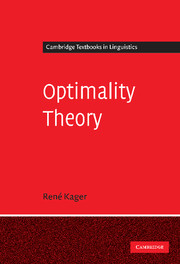
-
Select format
-
- Publisher:
- Cambridge University Press
- Publication date:
- June 2012
- June 1999
- ISBN:
- 9780511812408
- 9780521580199
- 9780521589802
- Dimensions:
- (228 x 152 mm)
- Weight & Pages:
- 0.79kg, 468 Pages
- Dimensions:
- (228 x 152 mm)
- Weight & Pages:
- 0.766kg, 466 Pages
You may already have access via personal or institutional login
Book description
This is an introduction to Optimality Theory, whose central idea is that surface forms of language reflect resolutions of conflicts between competing constraints. A surface form is 'optimal' if it incurs the least serious violations of a set of constraints, taking into account their hierarchical ranking. Languages differ in the ranking of constraints; and any violations must be minimal. The book does not limit its empirical scope to phonological phenomena, but also contains chapters on the learnability of OT grammars; OT's implications for syntax; and other issues such as opacity. It also reviews in detail a selection of the considerable research output which OT has already produced. Exercises accompany chapters 1-7, and there are sections on further reading. Optimality Theory will be welcomed by any linguist with a basic knowledge of derivational Generative Phonology.
Reviews
"This volume is an excellent introduction to the principles and worlings of optimality theory, a relatively new constraint-based framework....a superior introduction to the most current version of optamality theory..." Studies in Second Language Acquisition
"Kager's book provides a comprehensive overview of OT theory and practice....It is noteworthy for its attention to detail and its analysis of arguments." Lanuage in Society
Contents
Metrics
Altmetric attention score
Full text views
Full text views help Loading metrics...
Loading metrics...
* Views captured on Cambridge Core between #date#. This data will be updated every 24 hours.
Usage data cannot currently be displayed.
Accessibility standard: Unknown
Why this information is here
This section outlines the accessibility features of this content - including support for screen readers, full keyboard navigation and high-contrast display options. This may not be relevant for you.
Accessibility Information
Accessibility compliance for the PDF of this book is currently unknown and may be updated in the future.


